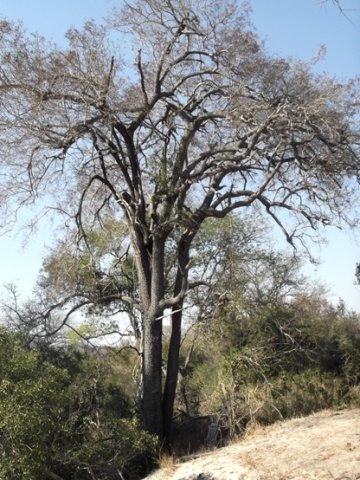Spirostachys africana

Spirostachys africana, the tamboti, is a medium-sized tree of around 10 m with a rounded crown and usually a single, erect trunk (SA Tree List No. 341). This magnificent specimen, leafless in winter, branched from the base.
The nearly black or dark grey bark, split into rough, hard and uneven patches that are thick and more or less rectangular from vertical fissuring and horizontal cracking, is one of the main identifiers of S. africana.
Another way to recognise tamboti is the three-lobed fruit capsule that bursts open conspicuously when the seeds ripen. What is more, in springtime these fruits are often infested with Knotthorn caterpillars, the larvae of a small moth that parasitises them. This causes the seeds to jump about randomly as the larvae move about inside the capsules. The name jumping bean was thus earned, but shared among several tree species of the region.
A member of the Euphorbiaceae family, it is no surprise that milky latex appears where damage occurs on living plant parts of the tamboti tree.
One finds tamboti trees throughout the northeast of South Africa, KwaZulu-Natal and the provinces north of the Vaal River, as well as in tropical Africa. It was seen in the Djuma Game Reserve.
Low altitude bushveld tends to have stands of several tamboti trees near watercourses, often close together. The species is not considered to be threatened in its habitat early in the twenty first century (Coates Palgrave, 2002; Wikipedia; http://redlist.sanbi.org).

